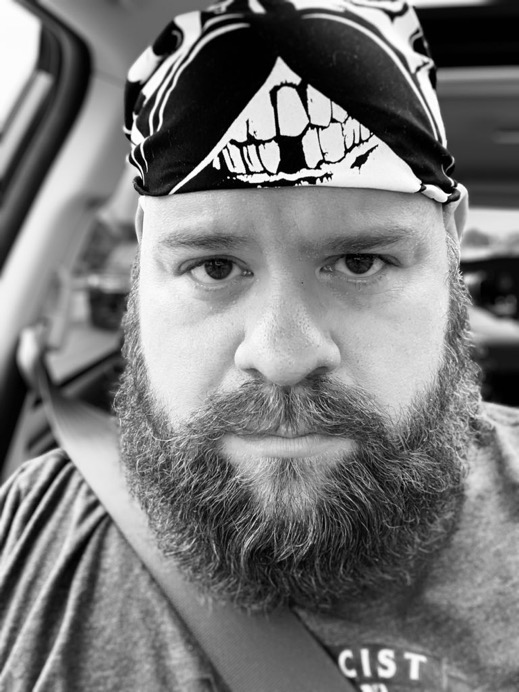
By Barlow Adams
I’d like to share a creative nonfiction exercise with you. It’s nothing fancy. It might even come across as simplistic if you’re a master of the form. Regardless, I use it time and again when I cannot produce under any other conditions. It rarely fails.
It may seem counterintuitive, but you cannot make someone feel with your writing. This is not to say your writing can’t invoke feelings. Hell, your writing can devastate, it can save, but, at the end of the day, you are a facilitator, not a conductor. You have no real power apart from what the reader gives you. Like Homer in Dante’s Inferno, you are a guide. Your influence begins and ends with the ability to take someone on a journey with your words. What they get out of the journey is entirely out of your control. To sloppily combine two cliches—you can lead a horse to the abyss, but you can’t make it stare.
What’s more, people have an innate response once they realize you are trying to make them feel something specific: they resist. Hard. We desperately want to feel something, anything, but we want to arrive at it as if by accident, some organic epiphany that we schedule at our convenience and dictate on our terms.
Consider the horror story. Consider the romance novel. We come to both with an expectation of arriving at a specific endpoint but balk at any attempt to have us follow a familiar trail. We scoff at the first recognizable landmark—the hint of a dark and stormy night, the mere mention of fated lovers—yet we long for the destination with everything in us. Terrify me, melt me, draw it out, make it inevitable, but don’t you dare let me know it’s coming.
The writer is left with the unenviable task of taking the reader on a trip to somewhere the reader has never been but will recognize on sight via a route that travels smoothly but never feels like a predetermined path.
So we beat on, straight-faced and adverbless, boats something, something pay no attention to the man behind the curtain, poo-tee-weet! Sometimes we even get there without blowing the whole thing, without being cheap or manipulative, without regurgitating tired cliches or splicing well-worn quotes to cover our personal deficiencies.
The trick to this is almost always avoiding sentimentality.
This is difficult enough in fiction, but in nonfiction it’s a different ratio entirely. The truer our story, the less of our emotion it requires and, too often, the more we instinctively pour in.
What we once intrinsically understood–that we cannot tell someone how to feel, that a story is as much a journey for the reader as it is the writer–gets quickly muddied because now this is our story. We extend ownership over it, inhabit it fully, embrace the unmitigated emotional response we originally experienced and pass that snarl of intensity on to the reader as naturally breathing: trauma in, sentiment out.
And in doing so wreck the covenant we agreed to as a guide.
Narrative nonfiction requires the courage to tell the truth and the wisdom to leave it alone, to bring a guest (or a few thousand of them if you’re lucky) to the most intimate, joyful, embarrassing, traumatizing moments of our lives, and let them set in judgement over that instant without interference. It is the ultimate in trusting your reader. The lightest touch will ruin the authenticity, the shadow of a thumb on the emotional scales and the reader will rebel precisely because you now have a literary dog in this fight. You no longer have the benefit of the doubt regarding your neutrality.
It’s human to defend ourselves, to clarify our intentions and put ourselves in the most positive light possible. Like taking a literary selfie, we instinctively seek out the best angle, filter how we are perceived. This is poisonous in creative nonfiction. If you are going to tell your story it must be a destination and not a campaign.
My challenge to you is to shepherd the reader to one specific moment in your history—nothing more, nothing less. Make it intense. Most of the time, if you can get a reader into the exact spot where you felt something important, they will feel it too. Or they will feel the opposite. They will feel something. Again, you have virtually no control over the manifestation. You may inform, but never direct.
Even at its most personal, a piece of CNF is never fully about you. If you wish it to be, write it in a diary. Show it to no one. Keep your reputation and your meticulously controlled narrative pristine and unknown. If you make it a story the point is to share. The most gut-spilling bone-naked version of you is still a proxy. Readers experience stories as themselves. Writing is never a solo activity, no matter how it feels. Nonfiction is no different, regardless of how singular it may feel.
Tell your truth. Heal your soul. But aspire to no higher office than to be the person telling the reader something they can believe. In a world overrun by politicking and branding the very act of presenting an unaltered account feels revolutionary.
Find your moment. Something that hurt you, thrilled you, made you feel alive or want to die. Envision the event. Where were you standing? What did you see? Now backtrack, focus on the things that led to the emotional endpoint. Walk it back to the start of the sensation. Now go forward. Eliminate any bias or sentimentality. Be a lens and nothing else. Concentrate on passing the journey to the reader. Apply the same stimuli but do not react. Let the reader react for you. There is no guilt or shame, no pride or benevolence. There is only the journey. Track the distance from inception to climax, leave out anything that does not increase the sensation. Keep going. Tell me what you find.
It will almost inevitably be a story worth telling, uncorrupted by your own revisions, unhampered by your hesitations.
Read Barlow’s other work here at Reckon.

Barlow Adams
Barlow Adams is a chronically ill writer in the Northern Kentucky area. He has survived kidney failure, lymphoma, and a saccular aneurysm. He occasionally wins writing awards and international competitions. He is overly fond of pie and smush-faced dogs.
